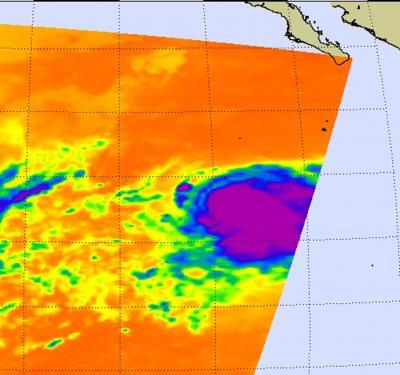The seventeenth tropical depression of the eastern Pacific Ocean hurricane season formed early on October 30 and quickly strengthened into Tropical Storm Rosa. Infrared data from NASA's Aqua satellite revealed strong convection in the storm's center, hinting at that intensification.
When NASA's Aqua satellite flew over Tropical Depression 17E at 5:41 a.m. EDT (0951 UTC) on Tuesday, October 30, the Atmospheric Infrared Sounder (AIRS) instrument took an infrared picture of the storm. The AIRS data showed a large, circular area of very strong convection (rising air that forms thunderstorms that make up a tropical cyclone) around the storm's center. Scientists identify the convection as strong, because the air pushes cloud tops of those thunderstorms to the top of the troposphere where temperatures are as cold as or colder than -63 Fahrenheit (-52 Celsius). The AIRS data showed that those clouds were near that temperature, indicating they were high in the atmosphere, and when they're that high, they're powerful, and are typically indicative of heavy rainfall.

The AIRS instrument aboard NASA's Aqua satellite captured this image of Tropical Depression 17 on October 30 at 5:41 a.m. EDT before it intensified into Tropical Storm Rosa. The strongest storms with coldest cloud top temperatures appear in purple. The purple indicates temperatures as cold as -63F (-52C).
(Photo Credit: : NASA JPL, Ed Olsen)
At 8 a.m. EDT (1500 UTC) the center of Tropical Storm Rosa was located near latitude 14.5 north and longitude 116.5 west. Rosa is moving toward the west-northwest near 7 mph (11 kph) away from the mainland. Rosa is expected to continue in that direction and turn more to the west in the next couple of days. Rosa's estimated minimum central pressure is 1004 millibars.
Rosa's maximum sustained winds were near 40 mph (65 kph) and the National Hurricane Center expects some strengthening later today and October 31 before weakening on November 1.
Source: NASA/Goddard Space Flight Center